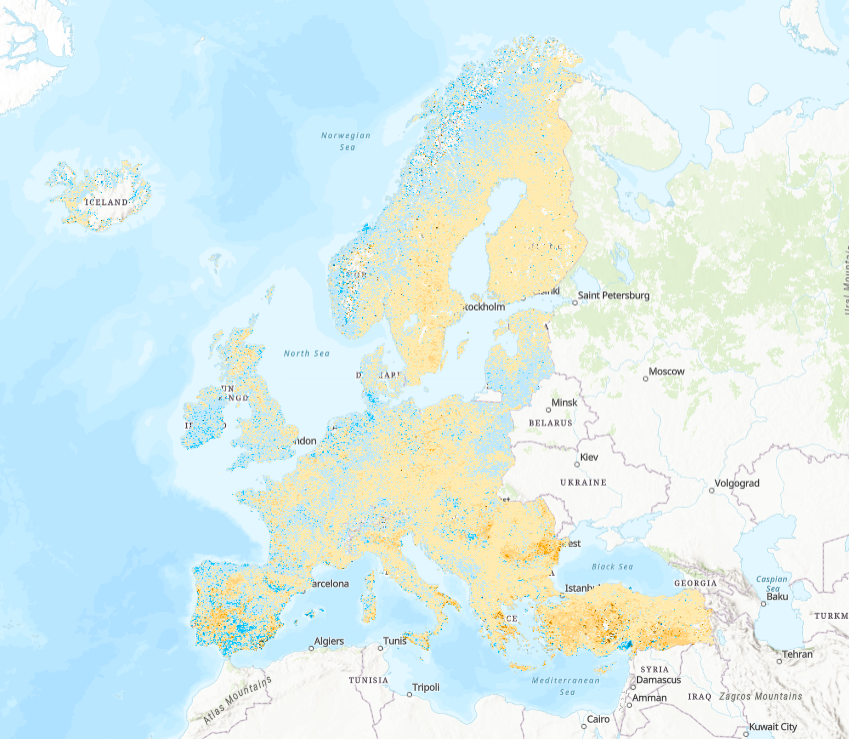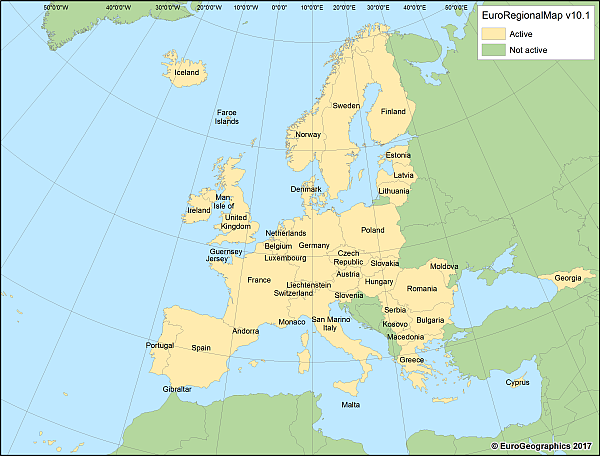vegetation
Type of resources
Available actions
Topics
INSPIRE themes
Keywords
Contact for the resource
Provided by
Years
Formats
Representation types
Update frequencies
status
Scale
Resolution
-

As a permanent service of Eurostat, GISCO: promotes and stimulates the use of GIS within the European Statistical System and the Commission; manages and disseminates the Geographical reference database of the Commission; acts as a reference centre concerning GIS; promotes geo-referencing of statistics and collaboration between national statistical institutes and mapping agencies; pursues and ensures standardisation and harmonisation in the exchange of Geographic Information; co-leads the INSPIRE initiative on the introduction of a European Spatial Data Infrastructure. Within the framework of the GISCO project, an extensive geo-referenced database has been developed. One of the main topics of the GISCO mandate is to extend, maintain and update this database. List of data sets offered by GISCO per ISO 19115 topic category (short name in []): a) Farming: farm accountancy data network [FADN] b) Biota: Natural Vegetation [VEGT], Biogeographical Zones [BIOG], Biotopes [BIOT] c) Boundaries: Territorial Units for Statistics (NUTS + Statistical Regions) [NUTS], Communes [COMM], Subcommunes [SCOM], Administrative regions [ADRG], Countries [CNTR] d) Climatology / Meteorology / Atmosphere: Climate [CLIM] e) Economy: Fishing Areas [FISH] f) Elevation: Digital Elevation Model [DEM], Bathimetry [BATH] g) Environment: Land Quality [LNQU], Designated Areas [DSIG] h) Geo-scientific information: Soil Erosion Risk [SOER], Geology Geomorphology ErosionTrend [ERTR], Soil [SOIL], Sediments Discharges [SDDS], Coastal Erosion [COER] i) Imagery/Base maps/Earth cover: Land Cover [LCOV] j) Inland waters: Water Patterns [WTPT], Lakes [LAKE], Watersheds [WTSH] k) Locations: Geographical Grid [GGGR], LUCAS [LUCA], Settlements [STTL], Gazetteer [GAZZ] l) Oceans: Coastline boundaries [COAS], Sea Level rise [SELV] m) Planning/Cadastre: Inter Regional [IREG], Leader Zones [LEAD], Less Favoured Areas [LFAV], National Support [NTSU], Structural Funds Zones [STFU], Urban Audit [URAU] n) Society: Population [POPU], Degree of urbanisation [DGUR] o) Transportation: Airports [AIRP], Ferry links [FERR], Ports [PORT], Road infrastructure [ROAD], Railway infrastructure [RAIL] p) Utilities/Communication: Nuclear Power [NUPW], Energy Production [ENPR], Energy Transport [ENTR] Further details can be found in gisco_naming_conventions_20090831.pdf
-

This data set raster file is the above ground vegetation season length time-series for the period 2000-2016. The data set addresses trends in the season length of land surface vegetation derived from remote sensing observed time series of vegetation indices. The vegetation index used in the indicator is the Plant Phenology Index (PPI, Jin and Eklundh, 2014). PPI is based on the MODIS Nadir BRDF-Adjusted Reflectance product (MODIS MCD43 NBAR). The product provides reflectance data for the MODIS “land” bands (1 - 7) adjusted using a bi-directional reflectance distribution function. This function models values as if they were collected from a nadir-view to remove so called cross-track illumination effects. The Plant Phenology Index (PPI) is a new vegetation index optimized for efficient monitoring of vegetation phenology. It is derived from radiative transfer solution using reflectance in visible-red (RED) and near-infrared (NIR) spectral domains. PPI is defined to have a linear relationship to the canopy green leaf area index (LAI) and its temporal pattern is strongly similar to the temporal pattern of gross primary productivity (GPP) estimated by flux towers at ground reference stations. PPI is less affected by presence of snow compared to commonly used vegetation indices such as Normalized Difference Vegetation Index (NDVI) or Enhanced Vegetation Index (EVI). The product is distributed with 500 m pixel size (MODIS Sinusoidal Grid) with 8-days compositing period.
-

The dataset described here presents the geometries of the zones and agglomerations reported since 2013 by Member States in compliance with the Ambient Air Quality Directives and successfully validated by the EEA's Quality Control system. In accordance with the procedure referred to in Article 5 of 2011/850/EU on the reciprocal exchange of information and reporting on ambient air quality, Member States shall make available the information set out in Part B of Annex II to this Decision on the delimitation and type of zones and agglomerations established in accordance with Article 3 of Directive 2004/107/EC and Article 4 of Directive 2008/50/EC and in which the assessment and management of air quality is carried out. .... These data flows are described on Reportnet's ROD (Reporting Obligation Database): https://rod.eionet.europa.eu/obligations/670 and https://rod.eionet.europa.eu/obligations/693. More meta-information on zones, including data providers can be found at http://aideb.apps.eea.europa.eu
-

This raster data set corresponds to the above ground vegetation biomass productivity time-series for the period 2000-2016. The data set addresses trends in land surface productivity derived from remote sensing observed time series of vegetation indices. The vegetation index used in the indicator is the Plant Phenology Index (PPI, Jin and Eklundh, 2014). PPI is based on the MODIS Nadir BRDF-Adjusted Reflectance product (MODIS MCD43 NBAR. The product provides reflectance data for the MODIS “land” bands (1 - 7) adjusted using a bi-directional reflectance distribution function. This function models values as if they were collected from a nadir-view to remove so called cross-track illumination effects. The Plant Phenology Index (PPI) is a new vegetation index optimized for efficient monitoring of vegetation phenology. It is derived from radiative transfer solution using reflectance in visible-red (RED) and near-infrared (NIR) spectral domains. PPI is defined to have a linear relationship to the canopy green leaf area index (LAI) and its temporal pattern is strongly similar to the temporal pattern of gross primary productivity (GPP) estimated by flux towers at ground reference stations. PPI is less affected by presence of snow compared to commonly used vegetation indices such as Normalized Difference Vegetation Index (NDVI) or Enhanced Vegetation Index (EVI). The product is distributed with 500 m pixel size (MODIS Sinusoidal Grid) with 8-days compositing period.
-

The raster file is the time series of the start of the vegetation growing season. The start of the growing season time-series is based on the time series of the Plant Phenology Index (PPI) derived from the MODIS BRDF-Adjusted Reflectance product (MODIS MCD43 NBAR). The PPI index is optimized for efficient monitoring of vegetation phenology and is derived from the source MODIS data using radiative transfer solutions applied to the reflectance in visible-red and near infrared spectral domains. The start of season indicator is based on calculating the start of the vegetation growing season from the annual PPI temporal curve using the TIMESAT software for each year between and including 2000 and 2016.
-

The raster file is the temporal trend in above ground vegetation biomass productivity. The vegetation productivity dataset is based on the time series of the Plant Phenology Index (PPI) derived from the MODIS BRDF-Adjusted Reflectance product (MODIS MCD43 NBAR). The PPI index is optimized for efficient monitoring of vegetation phenology and is derived from the source MODIS data using radiative transfer solutions applied to the reflectance in visible-red and near infrared spectral domains. The productivity indicator is based on calculating the area under the PPI temporal curve above the baseline (large integral - LINT) using the TIMESAT software. Relative change of vegetation productivity was then calculated as (YfitLINT2016 – YfitLINT2000)/YfitLINT2000 and expressed in percent scale [%]. Negative values refer to decrease in vegetation productivity, whereas positive values refer to increase in vegetation productivity.
-

The raster file is the temporal trend in the start of the vegetation growing season. The start of growing season dataset is based on the time series of the Plant Phenology Index (PPI) derived from the MODIS BRDF-Adjusted Reflectance product (MODIS MCD43 NBAR). The PPI index is optimized for efficient monitoring of vegetation phenology and is derived from the source MODIS data using radiative transfer solutions applied to the reflectance in visible-red and near infrared spectral domains. The start of season dataset is based on calculating the start of the growing season from the annual PPI temporal curve using the TIMESAT software. Change in the start of growing season was then calculated after fitting a linear trend and extracting the slope of the trend. Negative values refer to earlier start of the vegetation growing season, whereas positive values refer to later start of the vegetation growing season.
-

EuroRegionalMap is a Pan-European topographic vector dataset at scale 1: 250000, that is seamless and harmonized across boundaries. It is produced in cooperation by the National Mapping Agencies of the participating countries using official national databases. Thematic layers: Administrative Boundaries Hydrography Miscellaneous Named Location Settlement Transportation Vegetation and Soil Points of Interests
-

EuroRegionalMap v9.0 is a pan-European dataset containing topographic information at the scale 1:250 000 covering: 27 EU member states (excluding Croatia), 4 EFTA states (Liechtenstein, Norway, Iceland, Switzerland), Republic of Moldova, Serbia, Kosovo and Georgia. It is a seamless and harmonised data and is produced in cooperation by the National Mapping and Cadastral Agencies of Europe, using official national databases. Thematic layers: Administrative Boundaries, Hydrography, Settlements, Transport, Points of Interests, Named Location, Miscellaneous, Vegetation and Soil.
-

EuroRegionalMap (ERM) is a Pan-European topographic vector dataset at scale 1:250000, that is seamless and harmonized across boundaries. It is produced in cooperation by the National Mapping Agencies of the participating countries (NMCAs) using official national databases. Thematic layers: Administrative Boundaries (BND), Hydrography (HYDRO), Miscellaneous (MISC), Named Location (NAME), Settlement (POP), Transportation (TRANS), Vegetation and Soils (VEG) as well as Points of Interest. This metadata refers to the version 11.1 of ERM. For more information about the data product specifications and changes with respect to the previous version of this dataset (ERM v11 and ERMv10), please refer to the documents "ERM_v11-1_DataSpecification_EuroStat.pdf", "ERM_v11_TechnicalGuide.pdf" and "ERM(EC)_v11.1_Lineage_FullEurope.doc" provided with the dataset. Main changes with respect to these previous versions are that the NMCAs updated BND, HYDRO, MISC and NAME thematic layers, and that the Directorate-General for Mobility and Transport (DG MOVE) of the European Commission identified the Trans-European Transport Network for roads, railways, airports, ports and the watercourse system. This metadata has been slightly adapted from the original metadata file provided by EuroGeographics and is to be used only for internal EEA purposes. For reference, the original metadata file created by EuroGeographics is provided together with the dataset under the "metadata" folder.
 RUC Geo-Data catalogue
RUC Geo-Data catalogue